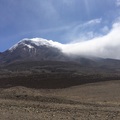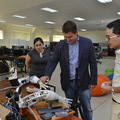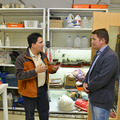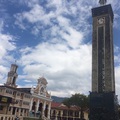01.08.2015.
Puno and Lake Titicaca
To understand Peru and the Peruvian people, one has to know the history and unique culture. The Lake Titicaca is important part of the history of Incas. The gods of the mountains (The Apus) created a fertile valley, where the people prospered under their protection. The Apus had only one condition: that they never go up the mountain where a sacred fire burned. People obeyed, until the Devil persuaded them to compete among themselves to see who was courageous enough to escalate the forbidden mountain. The Apus caught them midway, and sent pumas to eat those staying in the valley At the sight of the destruction of his creatures, Inti, the sun god, cried and cried for so long he inundated the valley. Only a boy and a girl survived the flood of tears. After the flood they found themselves next to a great lake, which had drowned the pumas sent by the Apus, turning them into stone statues. The couple then decided to call the lake Titicaca, which in their language means "lake of the stony pumas".
The floating islands of Urus was originally built centuries ago by the Urus native tribes with aim to isolate them from the Incas and other wild tribes. These islands are in the shallow parts of the bay of Puno. Now there are around 50 islands with 6-12 families in one island. The islands are built on the roots of totora, a local reed, which grows all around the lake. They cut 150-200 x 50 cm pieces from the reed, and they put them together with rope. One this basis they lay a one meter high level of reed, which has to be changed regularly and put new levels every week on the old one. This is why the "floor" of the islands are smooth and flexible. Originally the rope was made of leafs of corn and totora, but due to the water they eroded rapidly, that's why the substitute it with synthetic materials. Every family has a stone-based kitchen, where they cook. The houses are built of totora as well. The islands has to be replaced in every 20-22 years, when the foundation start to dismantle. Originally they earned living by fishing and commerce, now the main income are the tourists, they are selling artesian handworks and taking entrance fee in the islands.
One and half our ship-ride away is the (real) island of Taquile, where the locals still speaks the language of the Incas, the quechua (of course next to the Spanish). The island has a very special textile culture. The young boys are starting weaving when they are 7-8 years old, and they are able to weave a masterpiece hat with 14-15. This is important because the young girls are choosing (partially) they husband due to his ability of weaving. The solitary boys are wearing a special white-red hat, the marked ones are wearing red. Of course with rich motives on them. The solitary girls are wearing black headscarf with colourful motives, the married women just with red motives. Everyone wears folkloric clothes on the streets,mans just for the tourists. They say that a masterpiece hat needs a month work. I had a chance to have a look into very unique cultures during this one day trip.




